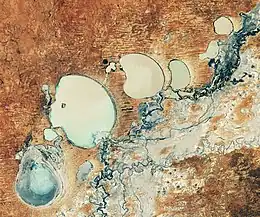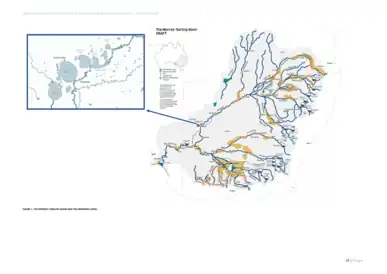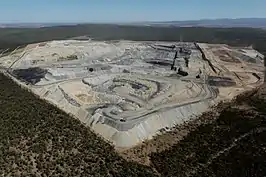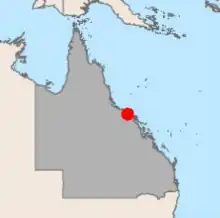Contemporary Australian environmental incidents
The following is a maintained list of contemporary Australian environmental and cultural incidents that have resulted in destroyed, degraded or damaged notable cultural or environmental items.
The intention of this list is to create a hospitable environment for the contribution and creation of a detailed lineage of intentional and unintentional anthropogenic activities or actors that continue to contribute to the ongoing degradation of Australian and First Nations cultural heritage and environmental sites.
The term incidents refers to any significant human activity, accidental or not, that contributes or creates the conditions in which environmental and cultural heritage is degraded. Conditions of degradation can be determined if the item or event, without human interaction would have sustained itself markedly better.
Entries considered suitable for this article
- The incident itself has an anthropogenic underlying cause or interaction
- The entry does not already have enough notability to warrant its own article, such as the Juukan Gorge disaster.
Fish kills also occurred in late 2022 and early 2023.[1]
Conventional ecosystems
Murray Darling fish kills (2018 and January 2019)
| Location | 40 kilometer stretch of the Darling River, both downstream and within Menindee Lakes |
|---|---|
| Site Description |  Menindee Lake Over 30 species of water birds use the lakes for habitat, including numerous threatened species. The Menindee Lakes play a prominent role in the early stages of native fish lifespan.[3] The lakes system provides water for numerous towns, including Broken Hill, Menindee and Pooncarie. Due to the flat landscape that makes up the river, along with inconsistent rainfall, flows into the system at the end of the end of darling river are inconsistent.[4] A significant feature of the lakes is the connection with the Lower Darling river via Weir 32, where "Flows into this section of the river support a range of agricultural and environmental assets"[3] The Darling river has a prominent involvement in Aboriginal culture dating back over 13,000 years. This region is the traditional land of numerous different nations, though the most prominent group is the Barkinji people.[3] Barkindji means people of the Barka (the river).[5] |
| Precedent | There are significant short and long term factors that contributed to the conditions of the river system causing three mass kill events. Diagram of the lake and surrounding Darling system. Ultimate causes: Large fish recruitment and spawning events Two large inflow events in 2012 and 2016 resulted in conventionally high biomass levels in Lake Pamamaroo & Menindee Weir pools.During high flow events, native fish move both downstream from the northern tributaries and upstream from the River Murray to greater proximity with the Menindee system. When full, the Menindee systems act as vast nurseries for fish.[4] These inflows and high water levels in the years preceding the fish - death event caused a large influx of both algal and fish presence in the systems. Weather and Water management After inflow events in 2016, Lake Menindee was considered at complete water levels. In 2017 - 2018 water was released from Menindee into the lower darling. Drought conditions in western NSW developed from 2016 onward, this cumulatively caused the "two-year total Barwon–Darling inflows" to be the "lowest on record over the past 20 years." Furthermore: "As part of the regular management operations for the lakes, water was released down the lower Darling system and into the River Murray".[4] Without any considerable in-flow events after 2016, alongside the diversion of water from the Menindee pools, weather levels began decreasing below Weir 32, effectively trapping remaining fish within the pools. Proximate causes / Late 20-18-2019: As conditions came to arrest water movements between the Menindee system, significant endogenous factors were also beginning to foster the environments that culminated in the 2018-2019 fish kill offs. As the independent assessment panel further notes:.This stratification causes a major separation of conditions in the water table... This stratification led to significant differences in oxygen and temperature levels between the epilimnion and hypolimnion. Algae concentrations most significantly changed during this event, with WaterNSW algal sampling showing very low concentrations of algae between July–September 2018 (none-detected). By the 24th of November, biomass levels had increased to over 8mm3/L (red-alert level). |
| Incidents and result | The Independent Panel report referenced here (Vertessy, 2019) and the Australian Academy of Science report (Moritz, 2019)[7] concur that the fish death events were caused by destratification of the pool upstream of Weir 32. The three major mortality events occurred on the 16th of December 2018 and the 6/19th of January 2019. The Independent assessment identifies three cool changes as the trigger for these two events. Alongside the final report, a preliminary report prepared by NSW Department of Primary Industries[8] after the second fish death event concluded that observed air changes and the subsequent water temperature falls are responsible for initiating major fish kill events. December Between the 12th and 16 December a significant cool change disturbed the stratification layers containing distressed fish and algae and widely different chemical and physical conditions. Average water temperature at 60 cm depth decreased from 27.5 °C on the 12th to 23.1 °C on the 16th, alongside rainfall on the 14th and 15 December.[4] The independent assessment panel notes... "This weather change likely triggered a mixing event that combined very low oxygen bottom waters with the surface waters where the fish were located." and.. "A change in conductivity that may be due to mixing of surface and bottom waters occurred in the early morning of 16 December 2018" This abrupt change altered the conductivity, temperature and oxygen saturations considerably, marking the start of the fish deaths that would occur following the 16th. The majority of deaths occurred in close proximity to Weir 32 January Upstream from Weir 32 cool changes altered the maximum air temperature from 46 °C on January 4, 2019, to 28.5 °C on January 5. Strong winds and substantial rainfall also occurred, reducing the weather temperature from 30 C on the 4th to 26 C on the 6th. Similar changes occurred on and prior to the two fish kills that occurred in January as demonstrated in the previous event during December. Although these two events featured headfirst, "further broader-scale fish kills occurred throughout, 600 km of the Darling–Baaka River as disconnected refuge pools contracted and water quality deteriorated from June 2019 to March 2020."[6] The exact number of fish deaths is unknown, though the report produced by Professor Rob Vertessy concluded that over a million fish may have died.[4] |
Mining and resource extraction related incidents
Whitehaven Coal billion litter water theft (2016–2019)
| Location | Whitehaven's Maules Creek mine is located 45 km southeast of Narrabri in north-east NSW within the Gunnedah Basin. |
|---|---|
| Site Description |  Maules Creek coal mine Leard state forest is home to 396 native species of plants and animals, 34 threatened species and numerous endangered ecological communities.[9] As of 2015 "Maules Creek [was] the biggest coal mine under construction and one of the few tier-one, undeveloped coal deposits in Australia."[11] The area expected to be impacted by the mine in its lifetime is approximately 2,177 ha. This consists of 1655 ha of forest and woodland and a further 413 ha of native grassland and 99 ha of exotic grassland.[12] |
| Precedent | Open cut coal mining requires significant water usage to mediate toxic dust and fine particles produced by their operation. Approximately 250 litters of freshwater are required for every single ton of coal extracted and produced. As the CSIRO further elaborates, waters involvement in coal mining includes:[13]
Whitehaven Coal specifically notes its use of water at Maules Creek site as:[14] "On site, water is used to suppress dust, to wash the coal in the Coal Handling and Processing Plant (CHPP) and across other miscellaneous areas. Some water is lost through evaporation." As Whitehaven Coal's water management statement notes: "The Maules Creek mine’s primary external water source is a 3000ML High Security water licence from the Namoi River, which flows during high rainfall events and from Keepit Dam periodic releases." More specifically related to the incident: "Other site water sources include rainfall into the pit and licensed groundwater allocations." |
| Incident and result | Whitehaven Coal was found complacent in two alleged breaches of section 60A(2) of the Water Management Act 2000 by extracting water unlicensed between 2016 and 2019.[15]
.jpg.webp) Protester blocking mining equipment within Maules Mine Notions suggests that Whitehaven did not take an active role in managing water resources its site was endowed with, instead choosing to use its private position as a primary benefactor of this resource. The court heard Principal Engineering Hydrologist at PSM, Doug Anderson statement that offense coincided with "the worst drought in living memory" [16] and that the value of that water to the environment had significantly higher value then normal Justice Pain notes that the ability to prove damages equivalent to a greater fine was more difficult, were:[16] "The prosecutor cannot prove to the requisite standard that the drought exacerbated actual harm to the environment" A Whitehaven spokesperson notes:[18]Whitehaven Coal was fined AUD $200,000 for unlawfully extracting 1 billion litters of water in 2021. Large public anger emerged from the perceived lack of severity of this fine. The maximum fine for this level of offense is 2 million AUD.[16] |
Adani Abbot Point coal spill (2017)
| Location | Caley Valley Wetlands |
|---|---|
| Site description | The Caley Valley Wetlands is a large coastal wetland ecosystem located ~25 km northwest of Bowen and south-east of Townsville. The wetland is designated to cover ~5,154 hectares and remains one of the only fully functioning wetland systems between Townsville and Bowen.[19] The wetland exists amongst a greater amalgamation of 5 main wetland systems located within the Great Barrier Reef catchment. The Wetland contains over 40,000 birds, made up of over 145 different species. It provides a breeding habitat for at least 24 species, including the most northerly location for coastal nesting black swans.[19]  Location of the Valley
The location adjacent to the wetland is mostly owned by North Queensland Bulk Ports corporation. The wetland itself is designated as an Abbot Point State Development Area and is therefore owned by the Coordinator General.[19] Abbot point is a significant export terminal for coal Bowen Basic Coalfields and located directly within the wetlands. |
| Precedent | Cyclone Debbie emerged as a significant tropical cyclone event in late March 2017. The strongest cyclone to strike Queensland since Marica in 2015, Cyclone Debbie was considered the deadliest cyclone to hit Australia since Fifi in 1991.[20]
As the cyclone moved south, the Queensland department of Environment and Science granted "Abbot Point Bulkcoal Pty Ltd a temporary emissions license (TEL) for the period 27 to 30 March 2017, to assist with site water management during and after TC Debbie"[21] The TEL authorized total suspended solids (TSS) releases of up to 100 milligrams per litre (mg/L) into the Caley Valley Wetland.[21] |
| Incident and result | Instead, "Adani has now admitted to the Queensland Government that they breached conditions of this license, exceeding their permitted pollution discharge limit to the ocean by more than 800 percent."[22]
This represents a breach of over 26 times the containment limit prescribed to Adani under their existing agreements with the Queensland Environmental authority. In the months preceding the runoff incident, government staff undertook a rapid assessment of the adverse effects the runoff created. The Caley Valley Wetland Monitoring Program Progress Report 2017 indicated that...The report concluded that in this instance, "this preliminary study found little evidence of contaminants in the surface sediments and waters of the Caley Valley wetland. Sediment samples collected in October 2018 and March 2019 showed that most samples contained trace or no coal fines". Queensland Department of Environmental Science has its own long-term monitoring program in the Caley Valley Wetland now implemented. |
Cultural heritage items
Djab Wurrung directions tree destruction (2018)
| Location | Djab Wurrung country where it and lands surrounding Budja Budja (Halls gap) are under the custodianship of Djab Wurrung people.[24] |
|---|---|
| Site description | The tree was located along a 12 km strip between the town of Buangor and Ararat.[25]
A direction or 'birthing' tree is a traditionally significant tree for Djab Wurrung peoples. As Djab Wurrung man Zellanach Djab Mara explains:[26] Aboriginal woman and Greens senator Lidia Thorpe expands the importance of such places for Djab Wurrung people in the continuation of living culture: Local landowner Mairi Anne Mackenzie said independent arborists had estimated the tree to be approximately 350 years old.[27] Arborists for the Eastern Maar Aboriginal Corporation[28] "have indicated that the tree in question is “highly unlikely” to pre-date European occupation". Furthermore, "Despite its age and majesty, extensive re-assessments did not reveal any characteristics consistent with cultural modification. It did not appear to have been altered by our peoples for usage in our cultural traditions". |
| Precedent | VicRoads and Major Road Projects Victoria, in attempting to reduce road accidents related to the particularly dangerous Western highway, maintain the necessity of expanding the highway to accommodate growing economic and social demands.[29] Between 2012 - January 2022, there have been 156 motor vehicle incidents, including 17 fatalities and 93 people seriously injured along the highway. It is expected traffic will double by 2025.[29] |
| Incident and result | In the preceding year, "Aboriginal landowners negotiated with the Victorian government to save around a dozen of 250 "culturally significant" trees from destruction."[30]These claims are contested by other Djab Wurrung peoples. Representatives from the Djab Wurrung Heritage Protection Embassy filed three separate injunctions against Environment Minister Sussan Ley decision making in the matter. The first of which was successful in discarding Ms.leys original approval. Although the environment minister was required to reconsider her decision making, the commonwealth in mid 2019 eventually denied the cultural significance of the trees, setting the precedent for their destruction later in the year.[32] Protecting culturally threatened sites has been the focus of many Djab Wurrung people, forming an embassy in proximity to the trees in mid-2018.[27] On the 26th of October 202012 police forces issued a move order to the remaining protestors surrounding the site. Approximately 50 people were arrested, in an amalgamation of charges related to failing to comply with the Chief Health Officer directions and obstructing police.[33] The tree was destroyed on the 26th of October, 2020. |
References
- "Fish kills in NSW". www.dpi.nsw.gov.au. 2023. Archived from the original on 15 March 2023.
- "Lower Darling - Catchment snapshot". NSW Department of Planning and Environment. 2 August 2018.
- "A profile of the Darling River system" (PDF). NSW Office of Environment & Heritage. 2017.
- Vertessy, Robert (2019). "Independent Assessment of the 2018-2019 Fish Deaths In the Lower Darling" (PDF). Independent Panel – via Murray-Darling Basin Authority.
- "Indigenous Heritage". Murray Darling Association.
- Stocks, Jerom R. (9 September 2021). "Kills in the Darling: assessing the impact of the 2018–20 mass fish kills on the fish communities of the Lower Darling– Baaka River, a large lowland river of south-eastern Australia". Marine and Freshwater Research, 2022: 73, 159–177 – via CSIRO.
- Moritz, Craig (February 2019). "Investigation of the causes of mass fish kills in the Menindee Region NSW over the summer of 2018–2019". Australian Academy of Science.
- "Fish Death Interim Investigation Report - Lower Darling River Fish Death Event, Menindee 2018/19" (PDF). Department of Primary Industries. 2019.
- Arthurslea (2016). "Icons Under Threat Leard State Forest NCC 2012" – via Yumpu.
{{cite journal}}: Cite journal requires|journal=(help) - Kibble, Gilligan and West (2012) NSW Planning Assessment Commission Review Report: Maules Creek Coal Project p11
- "Maules Creek Coal Mine, New South Wales". Mining Technology. 2015.
- "Maules Creek Coal Mine: Project Approval Modification Environmental Assessment". Hansen Bailey - Environmental Consultants. April 2013.
- Prosser, Ian (2011). "Water in mining and industry". CSIRO.
- "Water Management" (PDF). WhiteHaven Coal. 2019.
- "Whitehaven's Maules Creek alleged water theft further proof Vickery must not be approved". Lock The Gate. July 2020.
- Bell, Patrick (Nov 2021). "'Slap on the wrist': Farmers fume as Whitehaven Coal fined $200,000 for unlawfully taking water". ABC News.
- "Enforceable undertaking for Maules Creek Coal Pty Ltd". Natural Resource Access Regulator. 2021.
- Hannam, Peter (202). "Coal mining company accused of water theft". Sydney Morning Herald.
- "The Values of the Caley Valley Wetlands Report". Australian Marine Conservation Society. 2013.
- Kamenev, Marina. "Australia's worst cyclones: timeline". Australian Geographic.
- "Preliminary assessment of impacts to Caley Valley Wetlands from Abbot Point Coal Terminal post Tropical Cyclone Debbie" (PDF). Department of Science, Information Technology and Innovation. 2017.
- "Adani Abbot Point coal spill: Carmichael coal mine won't be any different". Australian Conservation Foundation. 2017.
- "Caley Valley Wetlands - Ongoing Monitoring Progress Report". Water Quality and Investigations Science Delivery - Division Department of Environment and Science. 2019.
- Djab Wurrung People. Budja Budja Aboriginal Cooperative.
- Jacks, T (2020). "jab Wurrung trees granted protection until February". The Age.
- "The Directions Trees Are More Than Just Trees". 3knd. 2021.
- Perkins, M (2020). "'Devastated': Anger after 'culturally significant' tree cut down at highway site". The Sydney Morning Herald.
- "Media release - Fiddle back tree and Western Hwy". Eastern Maar Aboriginal Corporation. 2020.
- "Western Highway Duplication". Victoria’s Big Build. 2022.
- "Djab Wurrung tree: Anger over sacred Aboriginal tree bulldozed for highway". BBC News. 2020.
- Higgins, Isabella (2022). "The destruction of a mighty fiddleback in Victoria sparks a common conundrum for Aboriginal Australians". 7.30 ABC.
- King, C (2022). "Western Highway's culturally significant trees denied Commonwealth protectio". ABC News.
- Bell, S (2020). "50 arrests as controversy rages over felling of Djab Wurrung tree at Western Highway upgrade site". ABC News.